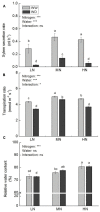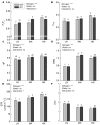Nitrogen Metabolism in Adaptation of Photosynthesis to Water Stress in Rice Grown under Different Nitrogen Levels
- PMID: 28690622
- PMCID: PMC5481364
- DOI: 10.3389/fpls.2017.01079
Nitrogen Metabolism in Adaptation of Photosynthesis to Water Stress in Rice Grown under Different Nitrogen Levels
Abstract
To investigate the role of nitrogen (N) metabolism in the adaptation of photosynthesis to water stress in rice, a hydroponic experiment supplying with low N (0.72 mM), moderate N (2.86 mM), and high N (7.15 mM) followed by 150 g⋅L-1 PEG-6000 induced water stress was conducted in a rainout shelter. Water stress induced stomatal limitation to photosynthesis at low N, but no significant effect was observed at moderate and high N. Non-photochemical quenching was higher at moderate and high N. In contrast, relative excessive energy at PSII level (EXC) was declined with increasing N level. Malondialdehyde and hydrogen peroxide (H2O2) contents were in parallel with EXC. Water stress decreased catalase and ascorbate peroxidase activities at low N, resulting in increased H2O2 content and severer membrane lipid peroxidation; whereas the activities of antioxidative enzymes were increased at high N. In accordance with photosynthetic rate and antioxidative enzymes, water stress decreased the activities of key enzymes involving in N metabolism such as glutamate synthase and glutamate dehydrogenase, and photorespiratory key enzyme glycolate oxidase at low N. Concurrently, water stress increased nitrate content significantly at low N, but decreased nitrate content at moderate and high N. Contrary to nitrate, water stress increased proline content at moderate and high N. Our results suggest that N metabolism appears to be associated with the tolerance of photosynthesis to water stress in rice via affecting CO2 diffusion, antioxidant capacity, and osmotic adjustment.
Keywords: nitrogen assimilation; nitrogen level; photosynthesis; rice (Oryza sativa L.); water deficit.
Figures









Similar articles
-
The knockdown of chloroplastic ascorbate peroxidases reveals its regulatory role in the photosynthesis and protection under photo-oxidative stress in rice.Plant Sci. 2014 Jan;214:74-87. doi: 10.1016/j.plantsci.2013.10.001. Epub 2013 Oct 8. Plant Sci. 2014. PMID: 24268165
-
Glycine increases cold tolerance in rice via the regulation of N uptake, physiological characteristics, and photosynthesis.Plant Physiol Biochem. 2017 Mar;112:251-260. doi: 10.1016/j.plaphy.2017.01.008. Epub 2017 Jan 12. Plant Physiol Biochem. 2017. PMID: 28107733
-
Nitrogen metabolism correlates with the acclimation of photosynthesis to short-term water stress in rice (Oryza sativa L.).Plant Physiol Biochem. 2018 Apr;125:52-62. doi: 10.1016/j.plaphy.2018.01.024. Epub 2018 Feb 6. Plant Physiol Biochem. 2018. PMID: 29413631
-
Exogenously-applied L-glutamic acid protects photosynthetic functions and enhances arsenic tolerance through increased nitrogen assimilation and antioxidant capacity in rice (Oryza sativa L.).Environ Pollut. 2022 May 15;301:119008. doi: 10.1016/j.envpol.2022.119008. Epub 2022 Feb 18. Environ Pollut. 2022. PMID: 35189299
-
Trade-off of within-leaf nitrogen allocation between photosynthetic nitrogen-use efficiency and water deficit stress acclimation in rice (Oryza sativa L.).Plant Physiol Biochem. 2019 Feb;135:41-50. doi: 10.1016/j.plaphy.2018.11.021. Epub 2018 Nov 20. Plant Physiol Biochem. 2019. PMID: 30500517
Cited by
-
Diversity, Distribution, and applications of arbuscular mycorrhizal fungi in the Arabian Peninsula.Saudi J Biol Sci. 2024 Feb;31(2):103911. doi: 10.1016/j.sjbs.2023.103911. Epub 2023 Dec 25. Saudi J Biol Sci. 2024. PMID: 38268781 Free PMC article. Review.
-
Oxidative Stress Response Mechanisms Sustain the Antibacterial and Antioxidant Activity of Quercus ilex.Plants (Basel). 2024 Apr 21;13(8):1154. doi: 10.3390/plants13081154. Plants (Basel). 2024. PMID: 38674563 Free PMC article.
-
Nitrogen Supply and Host-Plant Genotype Modulate the Transcriptomic Profile of Plasmodiophora brassicae.Front Microbiol. 2021 Jul 8;12:701067. doi: 10.3389/fmicb.2021.701067. eCollection 2021. Front Microbiol. 2021. PMID: 34305867 Free PMC article.
-
Osmotic Adjustment and Antioxidant System Regulated by Nitrogen Deposition Improve Photosynthetic and Growth Performance and Alleviate Oxidative Damage in Dwarf Bamboo Under Drought Stress.Front Plant Sci. 2022 Apr 14;13:819071. doi: 10.3389/fpls.2022.819071. eCollection 2022. Front Plant Sci. 2022. PMID: 35498701 Free PMC article.
-
Physiological analysis reveals the mechanism of accelerated growth recovery for rice seedlings by nitrogen application after low temperature stress.Front Plant Sci. 2023 Feb 16;14:1133592. doi: 10.3389/fpls.2023.1133592. eCollection 2023. Front Plant Sci. 2023. PMID: 36875613 Free PMC article.
References
-
- Akinci S., Sösel D. M. (2012). “Plant water-stress response mechanisms,” in Water Stress ed. Rahman I. M. M. (Rijeka: InTech; ) 15–42.
-
- Baker A. L., Tolbert N. E. (1966). Glycolate oxidase (ferredoxin-containing form). Methods Enzymol. 9 339–340. 10.1016/0076-6879(66)09069-4 - DOI
-
- Bates L. S., Waldren R. P., Teare I. D. (1973). Rapid determination of free proline for water-stress studies. Plant Soil 39 205–207. 10.1007/BF00018060 - DOI
LinkOut - more resources
Full Text Sources
Other Literature Sources

